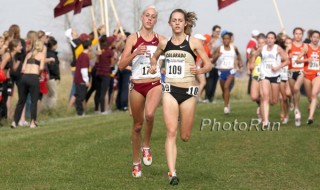How ‘Perception of Effort’ Can Make or Break a Race

Jenny Barringer was in front at the 2009 NCAA Cross Country Championships for a while. Photo: PhotoRun.net
Adapted from How Bad Do You Want It? Mastering the Psychology of Mind over Muscle by Matt Fitzgerald with permission of VeloPress. Learn more at www.velopress.com/howbad.
Jenny Barringer (now Simpson) was the best college runner in the nation in 2009, maybe of all-time.
So before her final meet, the 2009 NCAA Cross Country Championships, Sean McKeon of Competitor was merely stating a fact when he wrote, “If she doesn’t win, it will be the biggest upset in NCAA history, bar none.” He was also right—more right than he knew—to add that nothing short of an “epic collapse” would prevent her from winning the title she coveted.
But something happened. Barringer was leading halfway through the race yet was unable to drop Susan Kuijken of Florida State, Kendra Schaff of Washington or Angela Bizzarri of Illinois.
At the midpoint of the race, Kuijken noticed that she no longer felt Jenny pulling her along. In fact, she was coasting a bit, running slightly slower than she might be if she were alone. So she put a little more juice in her stride and immediately drew even with Jenny, who flinchingly sped up to reassert a half-step advantage. Moments later, Kuijken was again crowding Jenny from the back, getting increasingly antsy.
Jenny’s head began to bob. It was subtle at first, then not so subtle. The bob turned into a wobble. The wobble descended into her shoulders, trunk, and hips, until Jenny was lurching like a swollen-eyed prizefighter fumbling for his corner. Her speed dropped precipitously and Kuijken pranced away, hardly believing her luck. Jenny now appeared to be speaking to herself, her mouth making sloppy movements as she stumbled ahead. Her eyelids drooped to half-mast.
Kendra Schaff, Angela Bizzarri, and Sheila Reid of Villanova passed Jenny in a merciless single file. Seconds later, the main field caught her.
Jenny was a lost calf caught in a stampede of angry steer. She dropped to 10th place, 20th, 30th. Jenny’s former high school rival Erin Bedell, now a senior at Baylor, came upon her and was moved to help.
“Run with me!” Bedell called.
The greatest female college runner in history crossed the finish line 163rd in her last collegiate race.
The 2009 NCAA Cross Country Championships were covered live on the Versus cable television network. A camera crew awaited Jenny Barringer 30 feet beyond the finish line. She was still recovering her breath when reporter Cat Andersen stuck a microphone in her face and asked her what had happened.
“I didn’t feel so good halfway into it,” she answered tearfully.
The next day, Jenny recorded a 24-minute video interview for Flotrack from her hotel room in Terre Haute. Very little was added to her understated first explanation of the meltdown.
“It was a wave,” she said. “It was all of a sudden: ‘I don’t know if I can run. I don’t know if I can stand up.’”
More revealing, perhaps, than what Jenny did say about her unraveling was what she did not say. She did not say that she had pulled a hamstring, or suffered an asthma attack, or was struck by an agonizing abdominal cramp caused by a floating rib jabbing her diaphragm (which is what happened to Susan Kuijken, who finished in third place). Rather, Jenny’s terse description of her implosion seemed to suggest she had been brought down not by anything physical but by a feeling.
Is this explanation even plausible? According to the psychobiological model of endurance performance, it is.
The post How ‘Perception of Effort’ Can Make or Break a Race appeared first on Competitor.com.
Ryan Hall's Blog
- Ryan Hall's profile
- 21 followers



